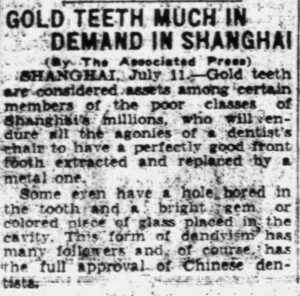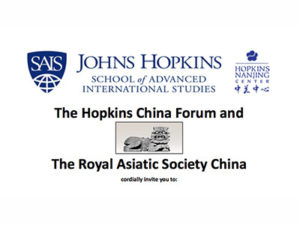Posted: July 20th, 2017 | No Comments »
Chase was a British author that, starting just before World War Two, began publishing pulp novels in the American hard-bitten style a la Hammett, Chandler and Cain. George Orwell thought him coldhearted and a worrying sign of both creeping Americanism and the commecialisation of crime in his 1944 essay Raffles and Miss Blandish. China Rhymers though with a taste for pulp crime novels might find his 1962 novel A Coffin from Hong Kong fun – it begins and ends in Pasadena but the bulk of the novel is set in late 1950s Hong Kong. And quite a good description of the city it is too – seedy hotels, Wan Chai bars, 3-class ferries, neon-lit Kowloon, refugees from Red China sleeping on the street corners, the old Repulse Bay Hotel and Lantau Island back in the day. There’s also a trip to Kowloon Walled City, some grizzled old Scottish colonial cops, landing at Kai Tak and a few good dinners along the way. All-in-all a pretty good speed read. Don’t let the covers put you off!!




Posted: July 19th, 2017 | No Comments »
Thursday, 20th July 2017
7:00 pm – 8:15 pm
Wooden Box
WINNING HEARTS AND MINDS: SOVIET PROPAGANDA IN CHINA IN THE COLD WAR
Guest: Alsu Tagirova
JOINT EVENT The Hopkins China Forum and RAS
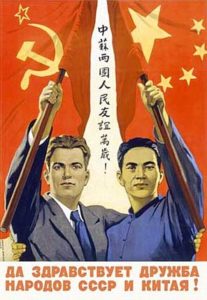
Convened in cooperation with the Hopkins China Forum, this talk deals with the evolution of Soviet public diplomacy in China, its main techniques and mechanisms, and its efficiency with respect to changing political goals. This was an important aspect of relations between China and the USSR, where similar ideologies and conflicting national interests were at the core of the bilateral relationship. Drawn from doctoral research making use of recently declassified Chinese and Russian archival documents, memoirs and interviews, this talk will shed light on social processes in both China and the Soviet Union, communication between the state and its citizens, and the role that the latter played in the formation of foreign policy.
Alsu Tagirova is an Assistant Research Fellow at the Institute for Studies of China’s Neighboring Countries and Regions, East China Normal University. She has been Postdoctoral Fellow at the Centre for Cold War International History Studies at East China Normal University, and a Visiting Scholar at the Woodrow Wilson Center for International Scholars in Washington, DC. She earned her BA from Kazan State University, and MA and PhD from Sun Yat-sen University. Her research interests include Sino-Soviet history and the Cold War, and her dissertation was on the history of Soviet Propaganda in China. Her current project is on the history of Sino-Soviet Border negotiations.
RSVP to Frank Tsai of China Crossroads : editor@shanghai-review.org
VENUE: Wooden Box; 9 Qinghai Lu (just to the South of Nanjing West Road) é’æµ·è·¯ 9 å·, è¿‘å—京西路, 地é“二å·çº¿å—京西路站 Shanghai
Posted: July 18th, 2017 | No Comments »
Poor Winnie the Pooh is getting blocked in China – you’ve read the story I’m sure and yes, Xi Jinping does look like Winnie a bit and probably hogs all the honey too. What is the official honey for state banquets?
However, nice chance to remember Yuen Ren Chao (1892-1982) a great Chinese scholar, teacher and translator. Chao knew everyone it seems – he was Bertrand Russell’s translator when the philosopher visited China in 1920. In 1925 he translated AA Milne’s (that’s the man who created Winnie the Pooh) one-act play The Camberley Triangle. Sadly it’s rather forgotten – both in the original and in translation. Wouldn’t it be lovely if he’d also translated Winnie the Pooh, but he didn’t. Instead Chao opted to translate Lewis Carroll’s Alice’s Adventures in Wonderland and Through the Looking Glass.
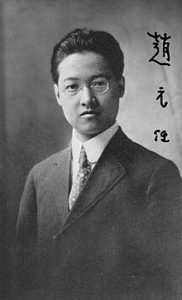
Posted: July 16th, 2017 | 1 Comment »
As this year is the 80th anniversary of Bloody Saturday (August 14th 1937) I thought I’d put together a “Penguin Special” reconstruction of that awful day from various eyewitness accounts of the dreadful bombings that hit the Palace and Cathay hotels on Nanking Road and then outside the Great World Amusement Centre over on Thibet Road in the French Concession. The eye witnesses include people caught up in the bombs, those that planned the raids on the Japanese flagship Idzumo that went horrendously wrong, journalists, hotel managers, firemen, police, Volunteer Corps members and others. It’s being published to coincide with the anniversary as Bloody Saturday: Shanghai’s Darkest Day….
Marking 80 Years since Shanghai’s Darkest Day
New Penguin Special by New York Times Bestselling Author Paul French

Published by Penguin Books China ISBN 9780734398550
Available throughout APAC from 7 August 2017 US$ 6.99 paperback,
E-book also available worldwide
On 14 August 1937 Shanghai’s history took a dark turn. As a typhoon approached the city’s horizons, so did bomber planes, and as citizens went about their daily routines, Shanghai experienced the worst civilian aerial attack to date. On that day, many lives were lost, and it is the eyewitness accounts of those that survived the violent attack outside the infamous Cathay Hotel close by the Bund and the Great World amusement centre in the French Concession that are reconstructed in a new Penguin short, Bloody Saturday. Paul French, an author known and awarded for a meticulous approach to narrative non-fiction, relives the day of horror that saw friendly fire tear the city apart.
Born and currently based in London, and educated there and in Glasgow, Paul French lived and worked in Shanghai for many years. He is a widely published analyst and commentator on China and has written a number of books, including a history of foreign correspondents in China and a biography of the legendary Shanghai adman, journalist and adventurer Carl Crow.
His book Midnight in Peking was a New York Times Bestseller, a BBC Radio 4 Book of the Week, and will be made into an international mini-series by Kudos Film and Television, the UK creators of Spooks, Broadchurch and Life on Mars.
Paul French is currently also working on City of Devils: A Shanghai Noir, which is centred on the dancehalls, casinos and cabarets of wartime Shanghai and is set to be published by Penguin China in November 2017.
Posted: July 15th, 2017 | No Comments »
I’ve blogged before about bad ass Bill Fairbairn, the creator of the Shanghai Municipal Police riot squad, expert knife fighter courtesy of some up-close-and-personal encounters in Shanghai’s back alleys (here). if you’re not familiar with the Shanghai Buster then just google him – he’s worth ten minutes of your time.
Anyway, Fairbairn of course had a life after Shanghai and was rather important in WW2 training commandos – both in Europe and America. A couple of books out recently mention his post-Shanghai activities and so China Rhyming readers might find them interesting….

Giles Milton’s Churchill’s Ministry of Ungentlemanly Warfare
 Keggie Carew’s Dadland
Keggie Carew’s Dadland
Posted: July 14th, 2017 | 1 Comment »
Marshall Smith Hairston of Stella, Patrick County, Virginia, went to Hankow and Shanghai in 1917 to work for British-American Tobacco. Later he moved to work as the factory manager for the Yee Tsoong Tobacco Co. in Pudong. Marshall married a Patrick County girl, Dixie Elizabeth McCabe in 1925, and they had three boys. Sadly, in 1926 one of his boys (Marshall Smith Hairston Jr.) died. Due to disruption across the country Marshall, who was up-country on business, heard of the trouble at Shanghai but could not get back to Shanghai easily as the rail lines were cut. It took him ten days to get home. When he did he learned that his child had died.
Marshall was apparently distraught and never got over not having been able to get back to Shanghai in time to protect his child. In July 1936 he checked into Room 302 of the Astor House Hotel, lay down on the bed, took his pistol and shot himself in the heart. He was discovered the next morning at 5.30am when his room boy came to wake him as arranged. He was 40 years old. He left behind his wife and two other children. He was buried at the Bubbling Well Cemetery in Shanghai. Dixie Elizabeth died in 1991 at 96.
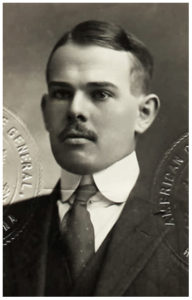
Posted: July 13th, 2017 | No Comments »
In the 1920s everyone had heard of the “Marrying Mdvani’s” – the sons and daughters of a super wealthy Georgian family who fled the Bolsheviks in 1921. By 1934:
- Serge Mdvani had married the actress Pola Negri, but dumped her after she lost all her money in the Wall Street Crash and married the opera singer Mary McCormic;
- David Mdvani married the actress Mae Murray, bankrupted her, got divorced and took up with the French actress Arletty;
- Isabelle Mdvani married the Spanish painter Jose Maria Sert;
- Nina Mdvani married a Stanford professor and later a son of Sir Arthur Conan Doyle;
- but perhaps Alexis Mdvani did best – he Louise Aster van Alen of the Astor family but, in 1931, divorced her to marry Barbara Hutton, the Woolworth heiress. They travelled a lot and in February 1934…
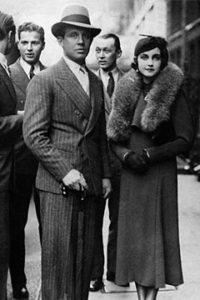
Prince Alexis Mdvani and Barbara Hutton, 1934
They arrived in China on their honeymoon tour…to much fanfare from the celebrity spotting China Coast press….
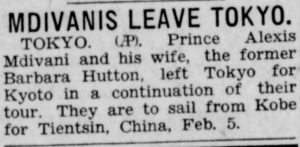 It was a good time for Alexis to be out the country as his brother Serge and David were in court accused of embezzling $8,000 from the fraudulent Pacific Shore Oil Company. The Mdvani’s sailed from Kobe to Tientsin (Tianjin) on the small steamer the Choko Maru (Below)…
It was a good time for Alexis to be out the country as his brother Serge and David were in court accused of embezzling $8,000 from the fraudulent Pacific Shore Oil Company. The Mdvani’s sailed from Kobe to Tientsin (Tianjin) on the small steamer the Choko Maru (Below)…

From Tientsin they headed straight to Peiping (Peking), but only one journalist was at the train station to intercept them…the journalist, rather like one of today’s hack pack in Beijing, found little of interest except to vulgarly mention money….
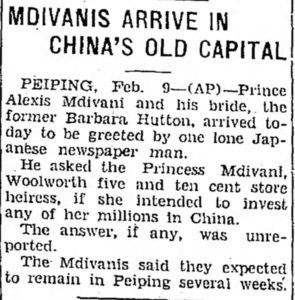 They obviously decided not to give the journalist the story he might have wanted most – and which they did announce from Peiping a few days later…
They obviously decided not to give the journalist the story he might have wanted most – and which they did announce from Peiping a few days later…
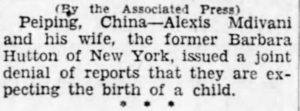 But don’t pop the champagne corks just yet – fake news, 1934 style!!
But don’t pop the champagne corks just yet – fake news, 1934 style!!
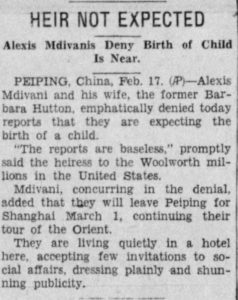 And so onto Shanghai…here they are, in resplendent furs, arriving at Shanghai North Railway Station just off the Peking Express. The young man on the left is Jimmie Donahue, Barbara’s cousin.
And so onto Shanghai…here they are, in resplendent furs, arriving at Shanghai North Railway Station just off the Peking Express. The young man on the left is Jimmie Donahue, Barbara’s cousin.
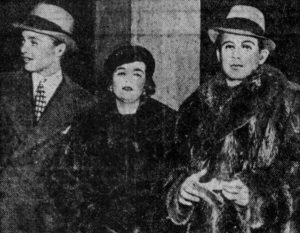
I think we can assume at the Cathay – this article interestingly shows just how wealthy Hutton was…
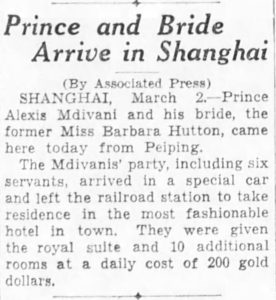
And then, after a couple of weeks (of fairly low key sightseeing and visiting) they decamped for Hong Kong….though (as so often I fear) time in Shanghai seems to have done their fledgling relationship no good at all…quarrels on-board the Conte Verde from Shanghai to Hong Kong are reported by fellow passengers…

From Hong Kong the couple boarded planes and got to Europe – Venice, Paris…all beckoned as the honeymoon continued. But China was not past…
Married in June 1933 the couple divorced in March 1935.
24 hours later she married Count Kurt Heinrich Eberhard Erdmann Georg von Haugwitz-Hardenberg-Reventlow.
Alexis was killed in a car crash in Spain in August 1935.
Posted: July 12th, 2017 | No Comments »
I have nothing to add – read it and come to you own conclusions…appeared in the press, July 1931…
